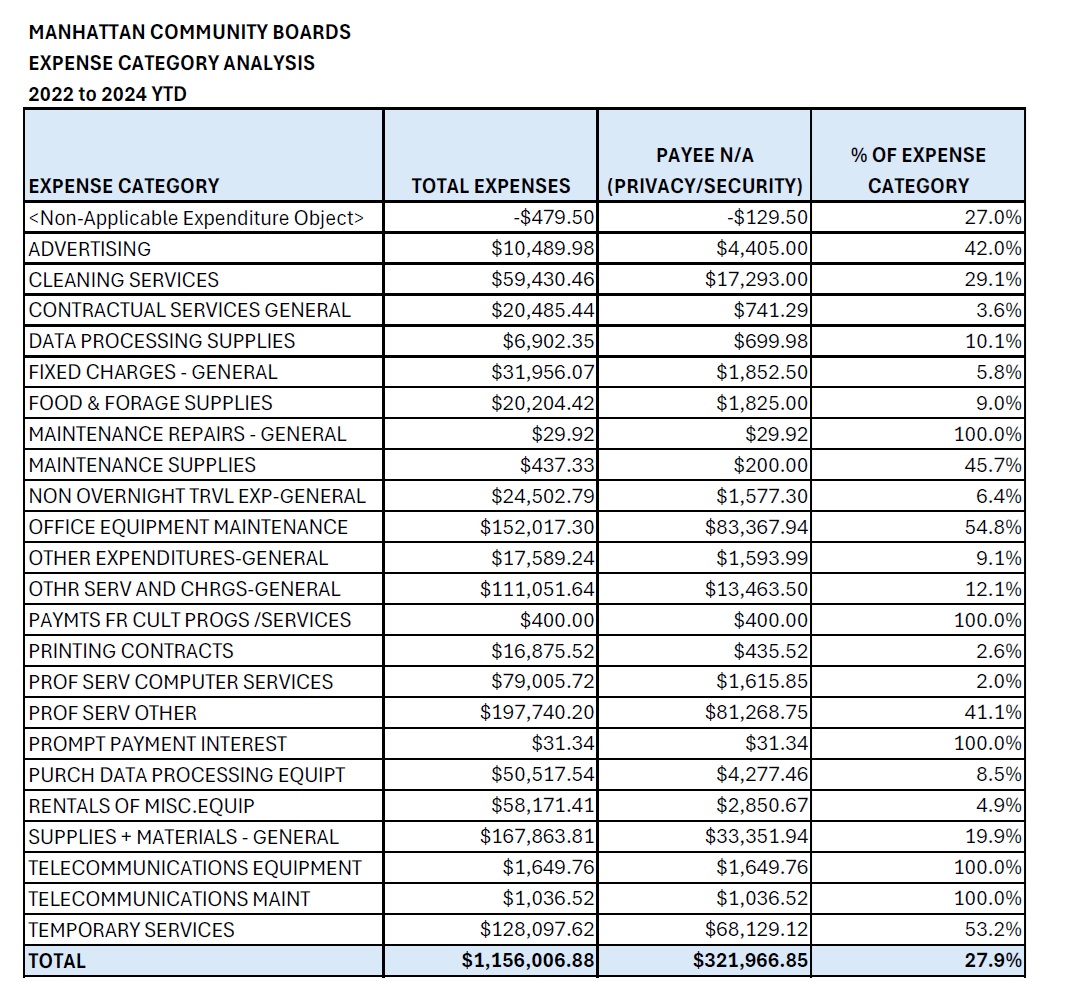How Manhattan’s Community Boards Shield Public Spending from View
Your tax dollars are disappearing into a black hole of secrecy in Manhattan. Since 2021, twelve community boards have hidden $382,716 in public spending behind a simple yet troubling label: “N/A (Privacy/Security).” They’ve marked both payee names and purposes as “N/A,” turning public expenses into private mysteries.
This vanishing act happens in plain sight. Every community board must hold public monthly meetings. They’re required to conduct open hearings on budgets. Their very purpose is to be the voice of their neighborhoods. Yet somehow, they’re keeping the public in the dark about where their money goes.
The oversight system looks impressive on paper. Manhattan Borough President Mark Levine appoints all fifty board members to two-year terms. Half these appointments come from City Council nominations. The Mayor ensures agency cooperation and proposes funding. The City Council maintains oversight powers. It’s a web of watchdogs – but nobody seems to be watching.
The Scale of Public Spending and Hidden Expenses
The numbers paint a damning picture. These boards manage real money – over $17 million since 2021, with $6.8 million in non-payroll spending. Before Levine took office, boards classified 3.4% ($60,749) of non-payroll spending as private. By his first year, that jumped to 5.2% ($82,184). Then to 6.7% ($109,428) in 2023. In just ten months of 2024, they’ve already hidden 6.9% ($130,353).
A Tale of Two Districts
The contrasts are striking. Community Board 9 hides 31% of its non-payroll spending – that’s $167,506 vanished into thin air. Meanwhile, Community Board 4 operates with complete transparency – zero dollars hidden. Adjacent to it, Community Board 2, encompassing Greenwich Village and SoHo, obscures 16.9% of its non-payroll expenses, totaling $57,108.
What’s Too “Sensitive” to Show You
Want to know what these boards consider too sensitive for public eyes? Since 2022:
- 54.8% of office equipment maintenance ($83,367) – classified
- 53.2% of temporary staff costs ($68,129) – hidden
- 41.1% of professional services ($81,268) – secret
- Even 19.9% of basic supplies ($33,351) – apparently too sensitive for you to know about
Here’s the kicker: some boards have classified 100% of their telecommunications expenses as private. They’ve even hidden a $31.34 late payment fee. Because apparently, late fees are now a matter of national security.
The Watchdogs Are Sleeping
This isn’t happening in a vacuum. Borough President Levine chairs both the Borough Board and Borough Service Cabinet. He coordinates service delivery and mediates disputes. The City Council has explicit oversight powers. The Mayor ensures agency cooperation. Yet the secrecy grows.
The silence from City Comptroller Brad Lander is deafening. His office has hundreds of staff and clear audit authority. Yet as privacy designations have skyrocketed – from $60,749 to $130,353 in the first ten months of 2024 – Lander watches quietly from the sidelines.
A Broken System
Think about this: One board operates with complete transparency while another hides a third of its spending. Both follow the same rules. Both handle similar expenses. Both answer to the same oversight authorities. The difference? Apparently, it’s just what they think they can get away with.
Questions That Need Answers
- Why are identical expenses public in some boards and secret in others?
- How did basic office supplies become sensitive information?
- Why is a late payment fee classified?
- Where are the watchdogs?
- Who’s protecting your right to know?
The Price of Secrecy
This investigation used nothing but public records – the same information available to every oversight authority. Yet it took an independent researcher to expose this pattern of growing secrecy.
These community boards exist to serve their neighborhoods. They’re required to hold public meetings. They’re supposed to be transparent voices for their communities. Instead, many have become black holes of public spending, enabled by the very officials charged with ensuring their accountability.
The time has come for answers. Borough President Levine, Comptroller Lander, and the Mayor’s office must either explain why basic expenses need privacy protection or restore true transparency to these vital public institutions. Your tax dollars – and your right to know how they’re spent – hang in the balance.
Methodology Note
This investigation analyzed complete financial records from all twelve Manhattan Community Boards from 2021 through the first ten months of 2024, focusing on expenses where both payee was listed as “N/A (Privacy/Security)” and purpose was listed as “N/A.” All calculations exclude payroll expenses to focus on discretionary spending. The 2024 data represents year-to-date figures only. All percentages and trends were calculated using official financial records and verified through multiple reviews.
Written by Sam Antar
© 2024 Sam Antar. All rights reserved.


